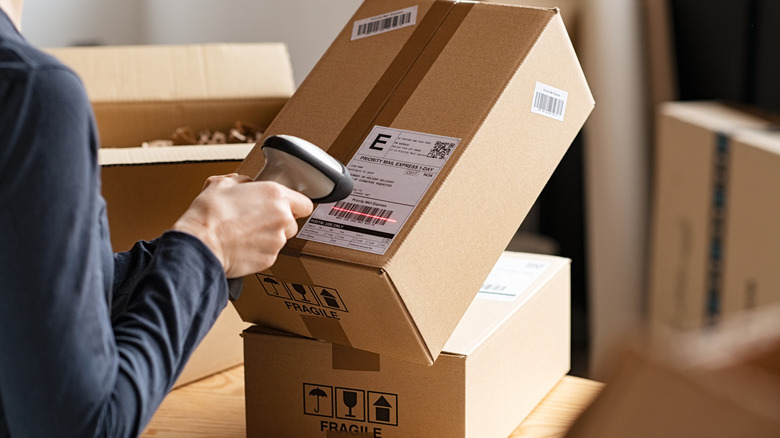Buyer Beware: Why Online Shopping Is So Much Trickier Than It Used To Be
If you've shopped on sites like Amazon or Walmart lately, you know that a search for something commonplace like a bath mat or a set of bedsheets can yield a plethora of results. Most will be sold by virtual shopfronts whose names look like they might have been created by a random letter generator and whose stock will boast of four- or five-star ratings and rave reviews. And while it might feel that we're spoiled for choice, the reality is far from it, because as The Washington Post points out, many of us are now tasked with wading through items of inferior quality to get to the things that we actually need or want to buy.
To be fair, these online stores, which have been peddling inferior goods or downright rip-offs, have been around for years. Back in 2019 and before the coronavirus pandemic broke out, The Wall Street Journal warned that there was a growing presence of online vendors which were selling items that were mislabeled, perceived to be unsafe because they had had bans slapped on them, or which had failed to meet federal safety guidelines altogether. The paper's audit uncovered over 4,000 items for sale, about half of which were for toys and drugs that didn't carry any health risk warnings, and more than 150 items which had FDA bans on them. Some even stood out because they were given an "Amazon's Choice" designation.
Questionable retailers are everywhere
The problem of dealing with sketchy retailers offering dodgy items isn't limited to online big-box retailers. Social media sites like Google, Facebook, and Instagram also feature ads for stores that sell slick and stylish items, often offering them at a fraction of what you think they might be worth (via The Washington Post), and there is one reason why so many of them are around: Business is booming. The pandemic, which saw many of us stuck at home, was a boon for virtual retailers, which reported $791.7 billion in sales for the year 2020. That figure is expected to exceed $1 trillion in 2022.
It might be easy for us to ignore the pop-up ads for stores that spoil our social media browsing experience, but that's not the case when we shop on sites like Amazon and Walmart, where substandard merchandise can take up virtual real estate. And unless the law requires it, there is very little fiscal incentive for these online giants to take down a third-party vendor. On its site, Amazon says it charges a "referral fee" for every item sold, which can range between 8-15%. It also charges for other services, which include advertising and a suite of unlisted "premium account services." It's small wonder then that In 2019, The Motley Fool reported that Amazon's third-party services were valued at $250 billion, while its actual retail operations had a value of $120 billion.
Double standards for different sellers
Amazon, which provides a virtual shopfront for these vendors through its Marketplace, has said that it takes product safety seriously, saying, "There are bad actors that attempt to evade our systems," and that if "should one ever slip through, we work quickly to take action on the seller and protect customers" (via The Wall Street Journal). But there are big loopholes in the Amazon system which allow these "bad actors" to get through.
Eric Mifold is an Amazon vendor who supplies products to the retail giant which then sells them to customers. He tells Inc. that as an Amazon vendor, he needs to produce papers that prove his products comply with strict federal safety guidelines. But third-party sellers who peddle their goods via Amazon Marketplace don't need to produce the same documentation, making it easy for substandard, counterfeit, and banned items to get through. These manufacturers get away with ignoring laws that require safety tests and proper labeling. Their products might be made with unsafe materials like chemicals that can potentially harm a user. And because these items are sold on the cheap, it is easy to see why they are snapped up by unsuspecting customers on a tighter budget.
Trust no one but yourself
It's left to us, as consumers, to decide which products will work and which could injure. To do this, shopping experts say you need to dig deep to find out whether a product is a real bargain, or if it is too good to be true. Another Washington Post article warns that spotting a dodgy item needs the same skills as those used to ferret out fake news. As Shireen Mitchell, founder of Stop Online Violence Against Women, warns: "No matter how intellectual you think you are, no matter how savvy you think you are — for tech or anything else — you have been victimized by disinformation at some point."
When you shop online, The New York Times recommends approaching unheard-of vendors and brands with the same caution (and grain of salt) you'd apply to shopping at a real-world flea market. Remember that sellers aren't obligated to carry items exactly as they are pictured. You need to buy items directly from a vendor and not from someone who will source the item from someplace else. Above all, know that ratings and reviews can no longer be used as a barometer of authenticity or reliability because, as Quartz points out, fake reviews, aka "deceptive opinion spam," are getting more difficult to spot. If an item sports numerous five-star ratings and displays reviews that sing its praises, are repetitive, may be filled with grammatical and spelling errors, and sound too good to be true, the item itself probably is just that.



